120 Presentation Topic Ideas Help You Hook Your Audience
Cooking is easy. The puzzle is figuring out what to eat. As soon as you know that, you can get started. The same holds for presentations. The sooner you can whip up a good, informative, and catchy topic, the easier the rest of the process becomes.
Pick a good topic that resonates with you and your audience to set a strong foundation. But select the wrong topic, and it becomes difficult to connect with your audience, find mutual interests, or hold their attention.
So, let’s learn how to develop thought-provoking and relevant topics for your presentations. You’ll also find some best practices to make your presentation memorable.
Table of Contents
- How to Choose a Great Presentation Topic in 5 Steps
- 120 Presentation Topic Ideas
- 5 Presentation Tips
How to Choose a Great Presentation Topic in 5 Steps
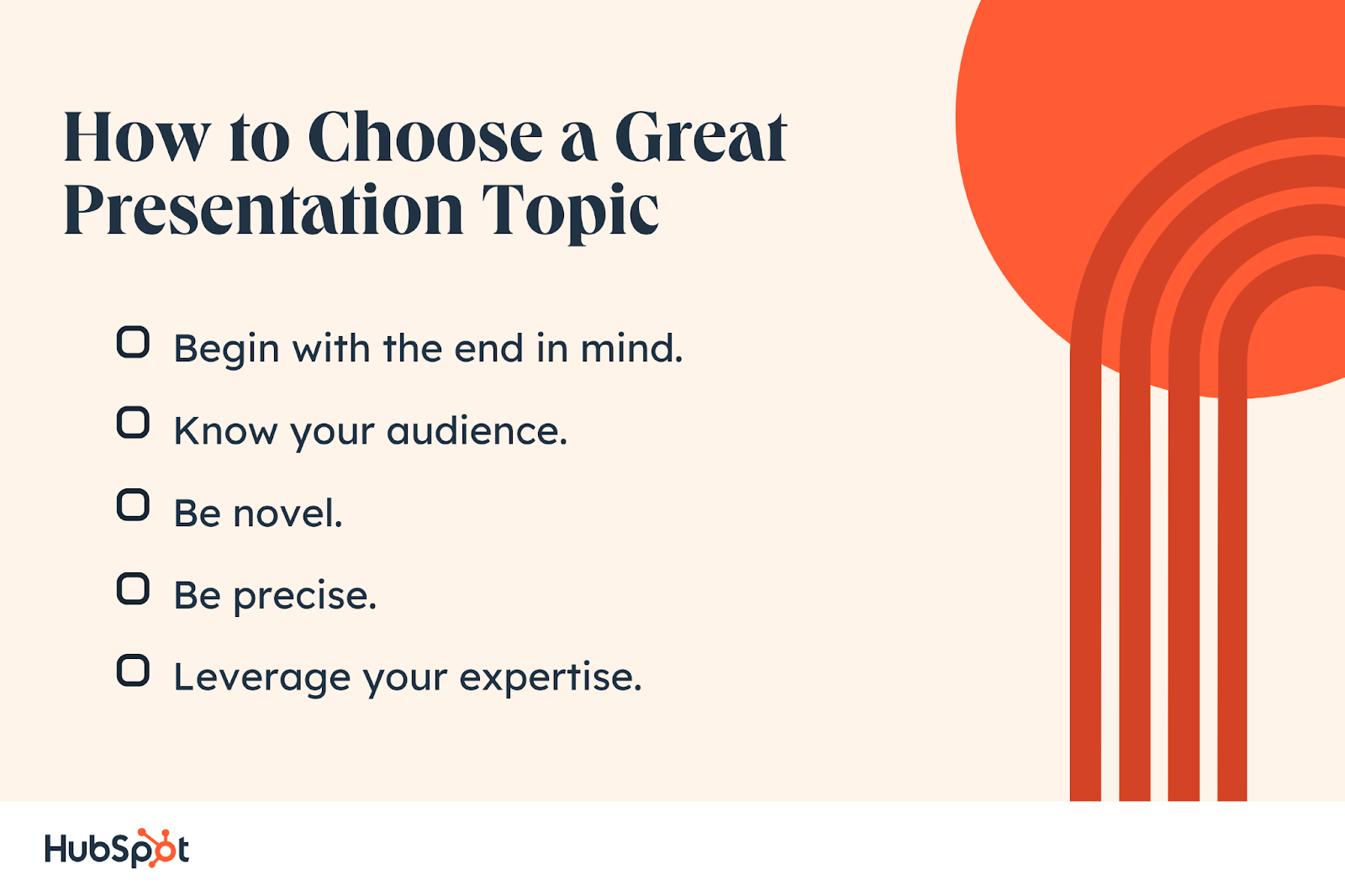
We’ve broken down the painstakingly long process of choosing a topic into five simple and easy steps. Let’s walk through it.
Step 1: Begin with the end in mind.
Identify the goal of your presentation by asking yourself:
- What do I hope to achieve from the presentation?
- How do I want to come across?
- What do I want my audience to take away from the presentation?
By keeping the end goal in mind, you’ll know exactly how to title your presentation.
Step 2: Know your audience.
Your audience is the star of the show. Get to know them by figuring out the who, what, and why.
Who is your audience? Profile your audience. Know their demographics, beliefs, knowledge level, and cultural backgrounds.
What are the problems that your audience is facing? Think about their pain points. Consider what they are going through and what situations they face daily. Maybe they’re already looking for a solution, or they need additional information to decide.
Why should they listen to you? Identify one or more clear benefits for your audience they will take home.
Pro tip: Always consider your audience’s knowledge level on the topic before drafting your presentation. For example, a presentation on social media targeted at Gen Z will differ from that targeted at Millennials.
Step 3: Be novel.
Make sure you either select a new topic or bring an entirely new and unique perspective to an already covered issue.
For instance, don’t make a presentation on the “best lead generation strategies.” Your audience has probably heard those dozens of times already. Corny.
Instead, discuss “How companies are using AI technology to implement lead generation strategies without lifting a finger.” Or add your own perspective, “How to seal a 1M deal: Our five best lead generation strategies.” Open a new window and let your audience see a fresh view.
Step 4: Be precise.
Once you have completed the first three steps, you probably have a few topic ideas ready. Now, cut out all the excess and select a niche topic with a very specific goal.
The broader your topic, the more difficult it will be for your audience to take away key ideas and actionable tips. Also, it’d be more difficult to gather an audience.
Discuss one problem and solve that problem only. By the end, your audience should have a clear idea of what they’ve gained from the presentation and what one (several at max) problems you helped solve.
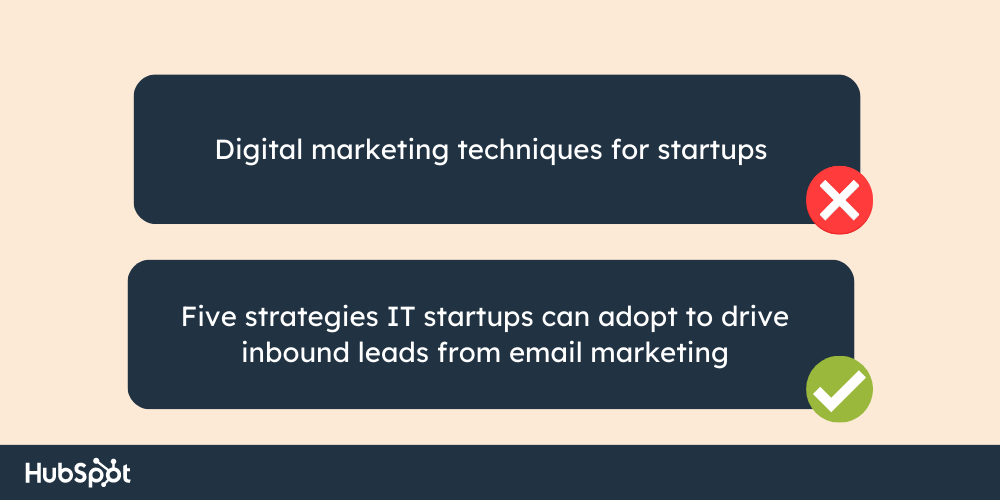
For instance, the first topic in the image is generic, sounds vague, and doesn’t specify any clear benefits.
In turn, the second topic mentions the target audience, tells them what to expect, and provides a clear, actionable plan. The audience knows exactly what they will take away from the presentation.
Step 5: Leverage your expertise.
The most important element that can make or break your presentation is you. The level of expertise you bring in, your interest, knowledge, and comfort with the topic determine the credibility of your presentation.
Pick a topic you’ve got first-hand experience with. Bring in a unique opinion or learnings/findings to add value to your words.
Let the audience view the topic from your perspective. In doing so, you can hook your audience and make your presentation original and memorable.
Also, choose a topic that you’re passionate about. The more enthusiastic you are about the topic, the more value and credibility you’ll bring to the presentation.
The audience will feel it and invigorate. And so will the lack thereof, which can be a big turn-off for your listeners.
Ever noticed how some people talk about sports? Their body language oozes energy and excitement.
Pro tip: Think about what excites you about the topic. Then narrow it down to 2 to 5 driving factors to focus on in your presentation.
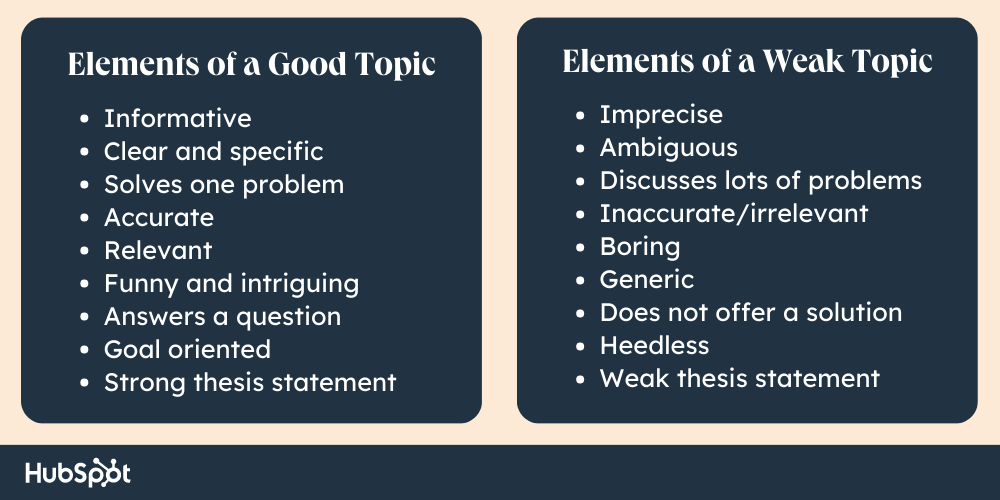
120 Presentation Topic Ideas
Find an extensive list of topic ideas from personal experiences to digital marketing and AI. So, the next time you’re planning a presentation, you won’t have to start from scratch.
Presentation Topic Ideas for Personal Experiences
- The failures that made “Me”
- My journey from having a full-time job to freelance work
- How has social media lowered my self-esteem?
- How I turned my weakness into a strength
- 5 ways to avoid procrastination
- Making money during holidays
- My battle with Covid-19
- Coping with anxiety and depression
- Leveraging my special skills
- Working remotely: pros and cons for companies and employees
- What I wanted to be and what I became
- How I rediscovered myself after the tragedy
Presentation Topic Ideas for Controversial Issues
- Future of genetically modified food and preservatives
- Privacy in the age of AI: Ethical issues
- The power of social media in politics
- Freedom of expression or harmful content
- Navigating the line between cultural appropriation and appreciation
- What can we do to prevent climate change?
- Genetic engineering: Ethical concerns vs. benefits
- LGBTQ: Balancing equality and tradition in a changing society
- The ethics of animal testing
- The implications of social media for future generations
- How much screen time is too much?
- Punishment vs. rehabilitation
Presentation Topic Ideas for Current Trends
- Five small efforts to fight climate change
- The emergence of digital assets in your daily life
- What are blockchain and cryptocurrencies?
- The latest fitness trends of 2023
- Life on social media vs. real life: How to keep yourself sane
- Water scarcity and conservation
- Renewable and sustainable energy sources: Are we ready?
- The benefits of mindfulness and meditation practices for new moms
- Understanding and addressing mental health issues in young people
- 12 Techniques for practicing self-care and self-compassion
- Adapting to remote and hybrid work models
- How X marketers grow their personal brands (and their ROIs)
Presentation Topic Ideas for Industry Insights
- How new AI technologies are changing the industry: 5 examples
- Six key trends and industry forecasts for the future
- How to overcome these 10 challenges to succeed?
- Measuring and optimizing organizational marketing efforts using AI
- Using predictive analytics to extract key marketing insights
- 13 strategies to increase customer loyalty and retention
- Improve your online visibility and traffic: 15 tips from LinkedIn gurus
- Seven ways to create engaging video content for your company
- Five ways for businesses to create a strong social media presence
- Which social media channels are best for your brand?
- Is AI revolutionizing the retail industry?
- Digital learning and the future of traditional learning systems
Presentation Topic Ideas for Digital Marketing
- The next big thing in digital marketing unlocked
- The art of storytelling in marketing: 23 businesses that kill it
- Benefits of cross-channel marketing for software development companies
- Voice search and its impact on digital marketing in 2024
- Maximizing ROI for your startup marketing: 3 underestimated tactics
- Changes in consumer behavior: Reasons and implications
- Importance of personalization in digital marketing
- 10 Emerging marketing trends and technologies
- Designing an effective mobile strategy for your business
- Importance of infographics in content marketing: HubSpot’s case study
- Creating effective marketing funnels for health products
- The power of user-generated content for companies
Presentation Topic Ideas for AI
- Six top stories about AI in 2023
- Five weird, but true, facts about AI
- What these three business experts are saying about AI
- Three shocking ways AI can make you a better marketer
- The dark side of AI
- Why has Elon Musk called to pause new AI research?
- Five AI tools every marketer needs
- AI and Big Data: Changing the landscape of modern business
- Which jobs will AI actually replace?
- Why does Bill Gates love AI?
- AI in human resources: Recruiting and talent management
- The Ethics of AI: Balancing business interests and societal impacts
Presentation Topic Ideas for Sales
- Cold calls: Unethical tactics and grey areas
- Sales: Expectations vs. Reality
- Sales prospecting made simpler with AI
- Sales calls: Do’s, Don’ts, and Musts
- Six sales strategies you need to throw out the window
- Five skills every salesperson needs to develop
- Building long-lasting relationships with customers using these three tried and tested methods
- Dealing with rejections: Five ways and one bonus tip
- Patient waiting and seven ways to deal with it
- 13 effective sales strategies for building relationships and closing deals
- Developing effective sales training programs for new employees
- 20 effective sales communication strategies
Presentation Topic Ideas for Time Management
- How to achieve an ideal work-life balance for remote workers
- How much time should you ideally spend networking on LinkedIn?
- How to effectively delegate tasks
- Buy back your time: Ways and benefits
- Six business principles of time management
- How to effectively plan ahead? Three practices you can start today
- 15 ways to improve personal efficiency and productivity
- The five steps of the Pomodoro Technique
- Goal setting and prioritization: For IT start-ups
- Nine best multitasking strategies of insanely successful businessmen
- Time management for busy professionals: Where to start?
- Eight ways to avoid procrastination you can start with tomorrow
Presentation Topic Ideas for IT
- Advantages and risks of adopting cloud software
- Open-source software: seven best practices
- Machine learning: Pros and cons for marketing
- How to create user-friendly interfaces for software and websites
- The role of IT in digital transformation
- The Internet of Things: five opportunities for businesses and consumers
- Six ways to protect your digital assets
- Seven benefits and three risks of moving to the cloud
- How does Big Data work?
- Best strategies to protect organizational data: five tried and tested techniques
- Technology and its impact on society and culture
- Mobile device management: Where to start?
Presentation Topics Ideas for Business
- Optimizing collaborations to save time across all departments
- Eight time management tools and apps for businesses
- 12 common skills of successful businessmen
- 10 tips and techniques for a successful marketing strategy
- Harnessing the power of influencer marketing
- Allocating a marketing budget to maximize ROI in five steps
- Five manufacturing techniques to minimize costs
- Understanding ethical issues in business and marketing
- 10 ways to minimize your company’s carbon footprint
- Three old business models making a comeback
- Seven ways Google developed a strong company culture
- 12 strategies for building a sustainable and responsible business in 2023
5 Presentation Tips
The best presentation topics always put their audience first, offer direct solutions, and fill in some knowledge gaps. But there’s more.
Don’t think of your presentation as a mere speech — it’s a ride you’ll take your audience on. There should be highs, lows, and revelations with a bang for an ending.
That being said, use these five tips to ace your presentation.
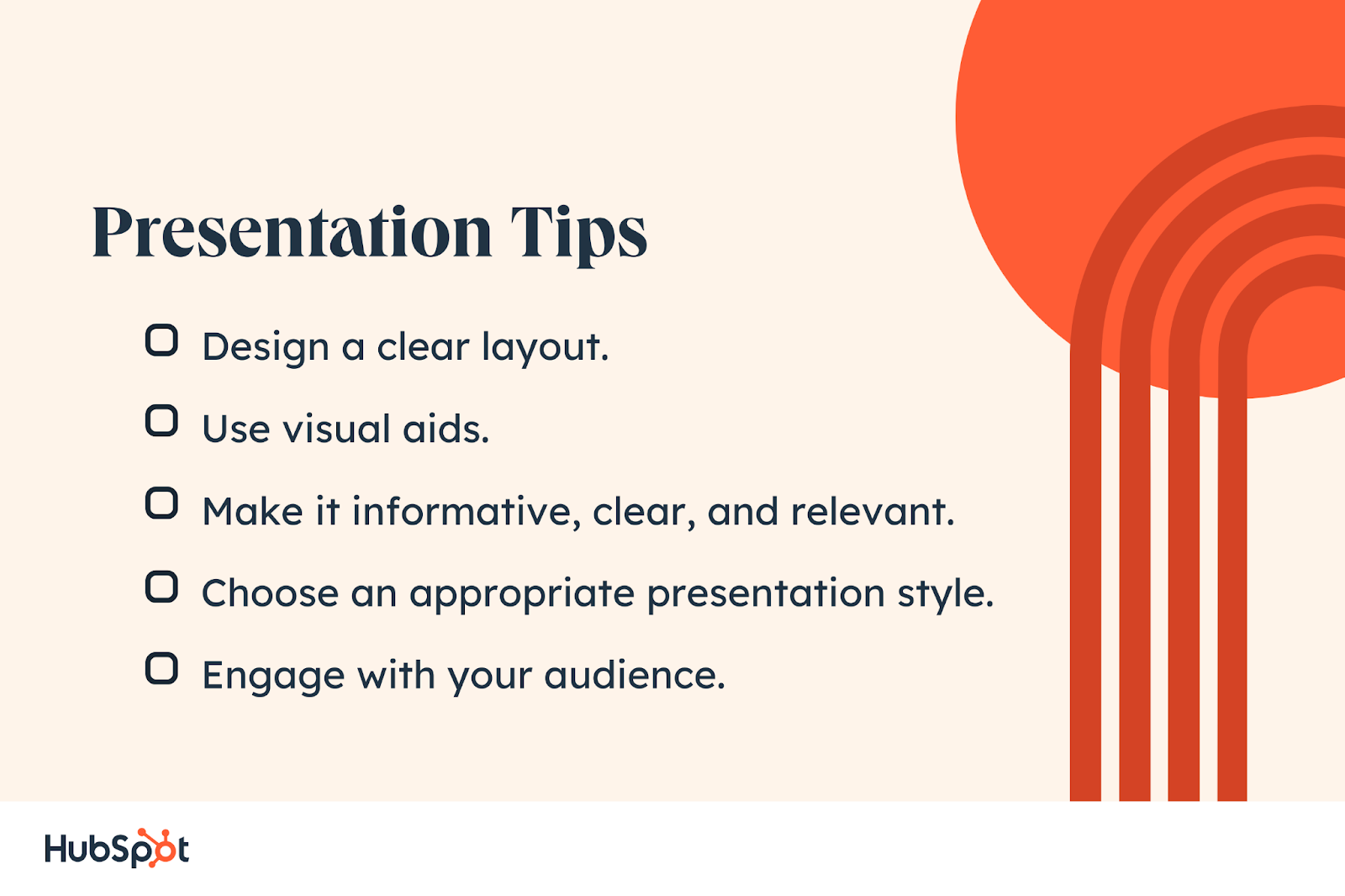
1. Design a clear layout.
Divvy up your presentation into four parts — introduction, body, conclusion, and follow-up — to construct a clear layout and attractive design. Let’s see what you should add to each.
- Intro: Add a catchy title with a hook. Explain a clear thesis statement or the main idea behind your presentation. Give a preview to your audience by including a table of contents so they know what to expect. The best introductions are creative and original, so let your imagination run wild.
- Body: Explain your topic and make your case. Sort the main idea into 3 to 5 key points. Arrange them in a logical order and make connections. Explain each point and use facts to bolster your claims.
- Conclusion: Make it concise. Summarize the main points and takeaways. Tie all the parts of your presentation together. And it’s best to end your presentation with a catchy line to inspire vivid discussions.
- Follow-up: Always leave some time for Q&A to dispel any doubts or to give any additional information the audience may require.
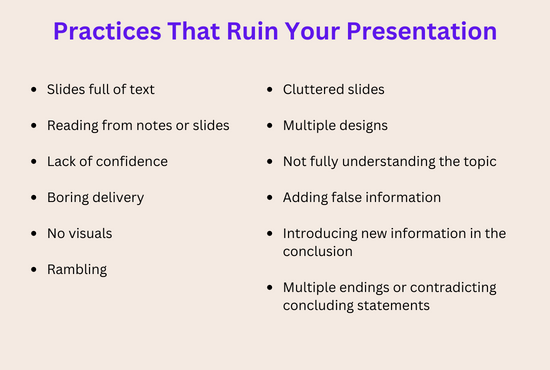
2. Use visual aids.
Use creative and attractive visual aids to stimulate emotions, simplify complex topics, and keep your audience captivated. Moreover, imagery helps your audience retain information longer.
Study shows that up to 60% of your audience is likely to remember visual content after three days. In turn, only 10% lives in memory when receiving information exclusively verbally.
So, include visuals like images, infographics, gifs, charts, and videos at the right time. Sometimes a picture is worth a thousand words.
Explore more on the topic: Learn how neuromarketing can improve the visual flair of your products and boost sales.
3. Make it informative, clear, and relevant.
You know your presentation has valuable information for your audience, but does your audience know that? Explicitly communicate actionable takeaways and benefits they will gain from it.
Select the best method to get the message across to your audience. Use relevant stories and examples to help you explain. People love stories; they move your audience while getting the message across. Most importantly, do it in a fun way.
Here are several tricks on how to do that:
- Have a great opening and closing line.
- Add facts and statistics to back up your information.
- Use emotionally triggering words to stimulate your audience and keep them attentive.
- Add humor and anecdotes to keep boredom away.
- Include intriguing and relevant examples to connect strongly with your audience.
- Use a vibrant color palette that’s easy on the eyes.
- Use slides more like a billboard. Make them easy to read and comprehend.
- Use less text, more visuals, and a limited number of bullet points.
Watch “The secret structure of great talks” by Nancy Duarte, an expert in presentation design and principal of Duarte Design.
4. Choose an appropriate presentation style.
There are many ways to present a topic. Your personality, the topic at hand, and your audience’s personas will help you determine which style would best fit you and your audience.
Select a presentation style that will communicate the main idea clearly and have a lasting impact on your audience.
For instance, explore a freeform style presenter by Sir Ken Robinson.
5. Engage with your audience.
Work on your presentation skills to make a strong connection with your audience, get through to them and leave a mark.
Think of the presenter as the link between the topic and the audience. A strong or a weak presenter can make a difference between a presentation being a thriving success or a boring failure.
Hone your skills by engaging and interacting with your audience. Make them feel like a part of the presentation and not just spectators. 70% of marketers have found presentations with interactive content to be more effective than those without.
Here are a few ways you can make your presentation interactive:
- Start your speech with uncommon questions to your audience. Involve them from the get-go, like ask to raise their hands if X.
- Make eye contact to build credibility and show confidence. Don’t stare at your slides or notes. Smile occasionally and talk to the audience directly.
- Have an active and confident body language. Don’t stand in the same place the entire time. Move around the stage.
- Don’t be monotonous. Speak as you would to a colleague — with enthusiasm.
- Ask close-ended questions in between to keep the audience engaged without losing time. Address them using their names to keep things interesting.
- Share personal experiences and stories that your audience will find fascinating and relatable.
- Practice thoroughly before you present so you’re fluent with the material and delivery.
- Energy and excitement can be quite contagious. Make sure you exude enough to spread some to your audience.
Feeling Inspired Yet?
Now you have all the right ingredients for choosing amazing topics and a hundred ideas to drive inspiration from. So, go ahead and start cooking presentations that will blow your audience away.
Don’t forget to choose a super-relevant topic and add meaty information. Do it with excitement to make it enjoyable for you and your audience. Best of luck!
![]()


![→ Free Download: 10 PowerPoint Presentation Templates [Access Now]](https://no-cache.hubspot.com/cta/default/53/2d0b5298-2daa-4812-b2d4-fa65cd354a8e.png)
![Blog - Beautiful PowerPoint Presentation Template [List-Based]](https://no-cache.hubspot.com/cta/default/53/013286c0-2cc2-45f8-a6db-c71dad0835b8.png)